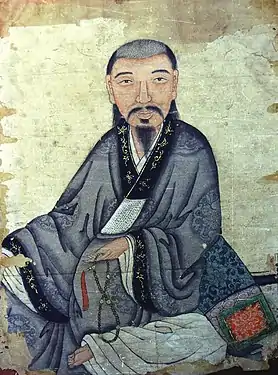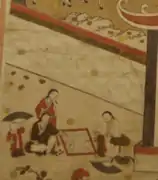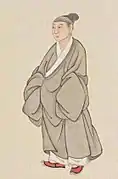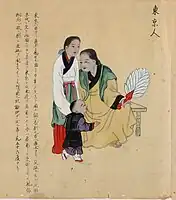| Áo giao lĩnh | |
 Áo giao lĩnh robes as depicted in a section of a 14th-century scroll, Trần dynasty | |
| Vietnamese | Áo giao lĩnh |
|---|---|
| Chữ Nôm | 襖交領 |
| Literal meaning | Shirt intersecting collar |
The áo giao lĩnh (襖交領; lit. 'shirt intersecting collar'), also known as the giao lãnh y (交領衣). Folk often call it áo tràng vạt (襖長拔) or áo tràng xiên, referred to as áo tràng, was a traditional cross-collared robe worn by Vietnamese before the 19th century. It was a version of a type of historical Han Chinese clothing[1] and was typically worn by the royalty, the aristocracy, the nobility, and the commoners.[2] During the Nguyễn dynasty, it was replaced by the áo ngũ thân and became obsolete.[3][4]
Construction and design
The áo giao lĩnh was a version of a type of historical Han Chinese clothing.[1] It is a robe with a wrap collar closing on the right side. The wrap collar closing on the right side is known as jiaoling youren (Chinese: 交領右衽; lit. 'intersecting collar right lapel') in China; garments with this form of wrap collar originated in China and started to be worn at least since the Shang dynasty (c. 1600 BC– c. 1045 BC)[5][6] before spreading to other countries.[7] Although the design of the áo giao lĩnh was heavily influenced by China, it was less constrained in style compared to its Chinese counterpart; and thus, facilitated ease of movements to its wearer.[2]

In the 17th and 18th century, the áo giao lĩnh worn by men was an ankle-level gown which could be used as part of a formal attire; it was composed of four-panel of fabric and was loose-fitting and featured a jiaoling youren collar, loose sleeves, and side slits.[8]: 72 It was typically not decorated and black in colour.[8]: 72 The women's áo giao lĩnh were also a non-decorated, four panel of fabric, loose fitting gown, similar to those worn by men.[8]: 72 Women usually tied a sash around their waist when wearing the áo giao lĩnh; the áo giao lĩnh came in blue, black, brown colours while the sash was either white in colour or found in the same colour as the áo giao lĩnh.[8]: 72
History
Prior to 18th Century
Prior to the 18th century, nobles wore the áo giao lĩnh, which were versions of Han Chinese clothing.[1] During the Lê dynasty (1428 – 1789 AD), aristocrats wore the áo giao lĩnh.[9]
18th Century
In the 18th century, the Áo Ngũ Thân (the precursor of the ao dai) replaced the áo giao lĩnh in order to meet the clothing requirement decreed by the Nguyen dynasty court during the rule of Lord Nguyễn Phúc Khoát in 1744 in order to distinguish the clothing worn between the people under his rule from the people ruled by the Trinh Lords.[1][9][10] The precursor of the ao dai then became the official clothing for both men and women in the South of Vietnam.[11]
19th Century
In the 19th century, under the rule of Emperor Minh Mang (r. 1820-1841), the clothing in Vietnam was finally standardized throughout the entire country when Emperor Minh Mang decreed that the ao dai had to become the national dress for all the regions under his rule.[12][13] The ao dai thus became the daily clothing of the Vietnamese.[13]
21st Century

In the 21st century, áo giao lĩnh worn in the 15th century was depicted in a book titled Weaving a Realm published by the Vietnam Centre (a non-profit organization which aims to promote the culture and image of Vietnam[14]).[15][16] The authors of the book mostly consisted of dress makers, artists, stylists, photographers, proof readers and editors (but lacked the presence of historians and archeologists) attempted to reconstruct the ancient clothing worn by Vietnamese through extensive historical research.[17] However, due to the lack of funds, the reconstructed clothing were not made with original materials or techniques.[17]
Gallery
- Áo giao lĩnh as depicted in various paintings and photos:
 Portrait of Prince Nguyễn Phúc Thuần from the 17th century. He wears a cross-collared robe (áo giao lĩnh) which was commonly worn by Vietnamese aristocrats before the 19th century
Portrait of Prince Nguyễn Phúc Thuần from the 17th century. He wears a cross-collared robe (áo giao lĩnh) which was commonly worn by Vietnamese aristocrats before the 19th century Giảng học đồ (Teaching), 18th century, Hanoi Museum of National History. Scholars and students wear cross-collared gowns (áo cổ chéo) – unlike the buttoned áo dài
Giảng học đồ (Teaching), 18th century, Hanoi Museum of National History. Scholars and students wear cross-collared gowns (áo cổ chéo) – unlike the buttoned áo dài Southern Vietnamese
Southern Vietnamese Two women and a child in Hanoi around the 1700s.
Two women and a child in Hanoi around the 1700s.
See also
- Áo viên lĩnh, round neck.
- Áo trực lĩnh, parallel splints.
- Garment collars in Hanfu
- Ru/ shan/ ao/ yi/ chang'ao
- Paofu
- Ruqun
References
- 1 2 3 4 "All about Vietnam Traditional Costumes". www.indochinatour.com. Retrieved 2021-06-30.
- 1 2 VietnamPlus (2019-05-13). "[Video] Áo Giao Lĩnh: Ngược dòng lịch sử cùng tinh hoa cổ phục Việt | Văn hóa | Vietnam+ (VietnamPlus)". VietnamPlus (in Vietnamese). Retrieved 2022-09-11.
- ↑ Vu, Thuy (2014), "Đi tìm ngàn năm áo mũ", Tuoi Tre, retrieved June 16, 2015
- ↑ Unknown, T.Van (2013), "Ancient costumes of Vietnamese people", Vietnamnet, retrieved June 16, 2015
- ↑ Zhao, Yin (2014). Snapshots of Chinese culture. Xinzhi Cai. Los Angeles. ISBN 978-1-62643-003-7. OCLC 912499249.
{{cite book}}: CS1 maint: location missing publisher (link) - ↑ Kidd, Laura K.; Lee, Younsoo (2002). "The Style Characteristics of the Hwalot, with a Focus on One Robe from the Collection of the Honolulu Academy of Arts". Clothing and Textiles Research Journal. 20 (1): 1–14. doi:10.1177/0887302x0202000101. ISSN 0887-302X. S2CID 110839493.
- ↑ Yu, Song-Ok (1980). "A Comparative Study on the Upper Garment in the Ancient East and West". Journal of the Korean Society of Costume. 3: 29–46. ISSN 1229-6880.
- 1 2 3 4 Howard, Michael C. (2016). Textiles and clothing of Viet Nam : a history. Jefferson, North Carolina. ISBN 978-1-4766-6332-6. OCLC 933520702.
{{cite book}}: CS1 maint: location missing publisher (link) - 1 2 "Áo Dài: History | VSAcademy | UNAVSA". Retrieved 2021-06-30.
- ↑ Fiona. "A Brief History of Traditional Vietnamese Ao Dai". Travel information for Vietnam from local experts. Retrieved 2021-06-30.
- ↑ Times, Vietnam (2020-07-09). "Precious photos of Vietnam's iconic Ao Dai in the old time". Vietnam Times. Retrieved 2021-06-30.
- ↑ "The Vietnamese "Áo dài" | Tập San Việt Học". Retrieved 2021-06-30.
- 1 2 "Vietnam's Ao Dai to be highlighted at Hue Festival 2020". en.nhandan.vn. Retrieved 2021-06-30.
- ↑ "About Us | Vietnam Centre - Bring Vietnam To You". Vietnam Centre. Retrieved 2021-07-01.
- ↑ Times, Vietnam (2020-06-14). "Weaving a Realm: Bilingual book introduces Vietnam's costumes from the 15th century". Vietnam Times. Retrieved 2021-07-01.
- ↑ ""Weaving A Realm" Book Crowdfunding Project | Vietnam Centre - Bring Vietnam To You". Vietnam Centre. Retrieved 2021-07-01.
- 1 2 "Book Review: Weaving a Realm, Vietnamese clothing from around 1500 AD | EXARC". exarc.net. Retrieved 2021-07-01.